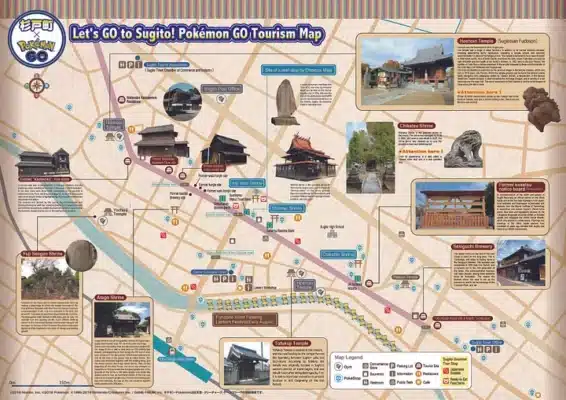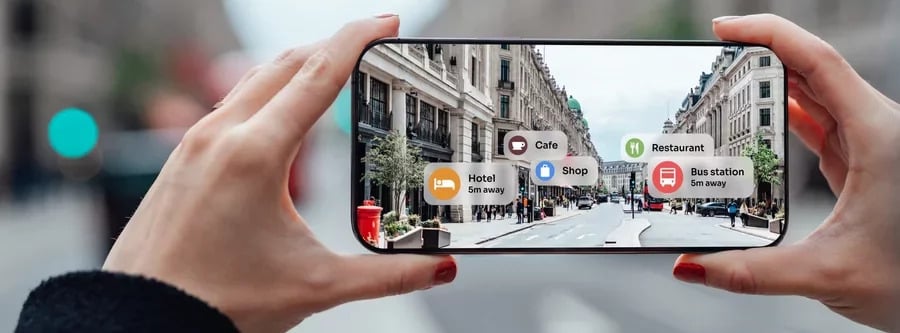Augmented reality (AR): the travel industry is also now being transformed by the introduction of immersive navigation tools, which overlay digital information with the real world to enhance travelers’ experience. American Express Travel’s Global Travel Trends 2023 report states,“Travelers want authentic experiences that give them a taste of local culture and allow them to explore hidden places their friends back home don’t know about.” Generation Z, 82 million people in the United States alone (source: emarketer.com) represents the largest and most technologically connected consumer group, making them a key target for travel companies. According to American Express Travel’s 2024 report, it is Generation Z, along with Millennials, who care more about a good travel experience than cost. Through mobile AR applications, tourists can explore destinations in a more interactive and engaging way, receiving detailed information directly on their device, improving navigation and interaction with the place they visit. Here is what has emerged from studies, statistics, and articles on the subject.
Sommario
- 1 Immersive navigation tools: a new way to travel
- 2 Concrete examples of mobile AR applications
- 3 Augmented reality and tourism, the studies
- 4 Augmented Reality (AR) in Tourism: advantages and limitations
- 5 Benefits for the Tourism Sector
- 6 Challenges and limitations of AR in tourism
- 7 Benefits for tourists and the industry
- 8 Ho to do: the tools to get started with AR in tourism
- 9 The future of augmented reality in tourism
- 10 What it means to rely on Intelligent Assisted Reality technologies.
- 11 REQUEST A NO-OBLIGATION DEMO
- 12
AR apps offer the ability to easily navigate unfamiliar cities or crowded places such as airports, museums, or tourist attractions. These tools use the smartphone camera to recognize the surroundings and display directions, points of interest, and historical information, overlaying the information on top of the actual view. A practical example is Google Maps AR, which uses the camera to provide real-time directions based on the surrounding environment. When the user points the smartphone at the road, the app shows directional arrows and signposts superimposed on the real images, helping tourists orient themselves without having to consult traditional maps. This increases navigation accuracy and reduces errors, making the experience smoother and more enjoyable.
Concrete examples of mobile AR applications
Among the apps that are pioneering this field is Explrar, a Singaporean startup that has developed an AR app for tourists. It is an app that combines artificial intelligence and augmented reality to offer historical and cultural information about landmarks and tourist attractions as users explore a city. How does it work? Simply point the camera at a point of interest to receive details in real time, enhancing visitors’ learning and interest. Another example is the Boarding Path app, designed to facilitate navigation at airports. Using augmented reality, tourists can receive precise directions to their gate or service areas by simply framing the space with their mobile device.
Augmented reality and tourism, the studies
A study related to tourism management found that location-based augmented reality (LBAR) integrated with the real landscape created a new hybrid experience space for tourists. While previous studies have analyzed tourists’ imagined memories or perceptions about AR, this study investigated the influence of LBAR on tourists’ spatial behaviors, experiences and intentions at three stages (before, during and after travel) through a field experiment combining objective behaviors and real-time perceptions. At the pre-trip stage, a survey showed that LBAR promotional videos increase tourists’ propensity to travel. During travel, a field experiment found that LBAR enhances innovative visual perception but reduces spatial exploration. After travel, results indicated that LBAR does not significantly increase intention to return. These results enrich theories of the tourism experience in hybrid spaces and offer empirical references for the use of advanced visual technologies at various stages of travel. Another article from the School of Hospitality, Food, and Tourism Management states that ” By encouraging tourists to use augmented reality (AR), destinations could leverage this technology to enhance tourists’ experience at different stages of a trip, namely: at the pre-trip stage, providing information and guidance for trip planning; during the trip, enhancing the on-site experience; and at the post-trip stage, providing information on satisfaction.”
Augmented Reality (AR) in Tourism: advantages and limitations
How is AR used in tourism?
AR offers numerous applications in tourism, transforming the travelers’ experience from passive to interactive and immersive:
- Navigation: Tourists can use AR to orient themselves in unfamiliar cities and easily find restaurants, hotels and attractions via their smartphones.
- Interactive experiences: AR allows tourists to have authentic experiences, interacting with the local environment in new and meaningful ways. For example, they can discover the history of a monument simply by framing it with their device.
- Museums and cultural sites: AR increases the educational value of tourism. Visitors can interact directly with the environment by viewing historical reconstructions or simulations of past events.
- Translation and communication: AR can break down language barriers, translating signs and menus in real time and facilitating communication between tourists and locals.
- Personalized recommendations: AR apps can provide personalized recommendations on what to visit or where to eat, based on the traveler’s preferences.
Benefits for the Tourism Sector
- Greater Engagement: AR makes tourism experiences more engaging and personalized, improving customer satisfaction.
- Increased revenue: Unique experiences can motivate tourists to spend more or choose certain services.
For example, Snapchat found that using AR during travel planning increases average spend. In addition, according to Threekit,“Augmented reality (AR) product experiences are 200 percent more engaging because they offer twice the level of interaction than their non-AR equivalents.”
- Data and analytics: AR can provide detailed information about customer behavior, helping companies improve tourism offerings and make informed decisions.
Challenges and limitations of AR in tourism
- Technology barriers: Many tourism destinations have poor network coverage, hindering the smooth use of AR. In addition, mobile devices with little computing power or limited battery life can reduce the effectiveness of the experience.
- Security and privacy: AR involves the collection of personal data, raising privacy concerns. Tourism companies must ensure that they adequately protect user data and comply with local regulations, such as GDPR.
- Authenticity: Although AR enriches the tourism experience, overuse may reduce the authenticity of the destination. AR should be used to enhance the experience, not replace it.
Benefits for tourists and the industry
The use of AR applications in tourism enables travelers to explore new destinations independently, reducing dependence on tour guides and enhancing the quality of the travel experience. Tourists can access detailed information about the places they visit in real time, enhancing cultural knowledge and interaction with the environment. There are benefits for the target industry as well: AR apps offer tourism businesses an innovative way to attract and engage customers. Gamification also makes explorations more fun and interactive, stimulating curiosity and increasing the visitor’s stay in a given place. Augmented reality is emerging as a key tool in enhancing the travel experience, enabling intuitive navigation and immediate access to rich information content. Case Study – Pokemon Go: An AR game that motivated users to explore cities. This demonstrates how AR can be used to engage tourists. – Google Maps and Translate: They offer AR features to explore places and translate text, making travel more accessible. 
Ho to do: the tools to get started with AR in tourism
To implement AR, tourism businesses must:
- Set clear goals;
- Select appropriate platforms and tools;
- Collaborate with technology partners;
- Measuring outcomes through data analysis.
The future of augmented reality in tourism
With the spread of 5G and the Internet of Things (IoT), AR will become increasingly accessible. In addition, 5G networks will enable greater connectivity and a faster and more immersive AR experience. Future tourism will see increasing integration between AR, VR, and MR, with new opportunities for tourism businesses, such as personalized virtual tours and advanced customer behavior analytics. With the advancement of mobile technologies and the large-scale adoption of AR apps, the future of tourism will offer more travelers the opportunity to explore the world with immersive tools that will enrich the journey in every aspect.
<strong>Request a free demo</strong>
What it means to rely on Intelligent Assisted Reality technologies.
With Fastbrain and RealWear, customer satisfaction can be increased by making work more efficient and easier. Experts can, through smart glasses, guide, train and assist technicians in the field hands-free as they do their work. RealWear solutions support companies in every industry with the best AR smart glasses on the market, under the banner of continuous innovation and sustainability.
Contact one of our experts for free
References: “Top 10 Augmented Reality Trends & Startups 2024.” StartUs Insights, 2024 “The Future of AR in Travel and Navigation.” TechRadar, 2023. “Augmented Reality is Changing Travel for Good.” Forbes, 2023. https://www.sciencedirect.com/science/article/abs/pii/S0261517724000050 https://mize.tech/blog/5-ways-augmented-reality-is-enhancing-the-tourism-experience/ https://journals.sagepub.com/doi/abs/10.1177/1467358420941913?journalCode=thrb
About Fastbrain and why to choose it
We are Certified Partners of leading Technology Players, offering customized solutions, pre-sales and after-sales support and operational rental included. As a RealWear Gold Partner, we offer state-of-the-art assisted reality solutions designed to connect and collaborate with experts remotely, track digital workflows, visualize IoT data, and more. Safely reduce downtime, improve quality and employee productivity, while realizing a significant return on investment. Discover all the benefits of intelligent assisted reality for your Company.
Info: info@fastbrain.it | Tel 011.0376.054


